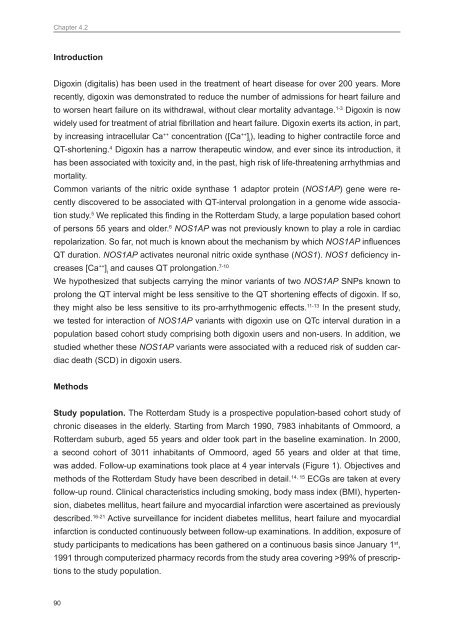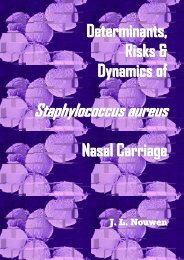Genetic susceptibility to adverse drug effects - Epidemiology ...
Genetic susceptibility to adverse drug effects - Epidemiology ...
Genetic susceptibility to adverse drug effects - Epidemiology ...
Create successful ePaper yourself
Turn your PDF publications into a flip-book with our unique Google optimized e-Paper software.
Chapter 4.2<br />
Introduction<br />
Digoxin (digitalis) has been used in the treatment of heart disease for over 200 years. More<br />
recently, digoxin was demonstrated <strong>to</strong> reduce the number of admissions for heart failure and<br />
<strong>to</strong> worsen heart failure on its withdrawal, without clear mortality advantage. 1-3 Digoxin is now<br />
widely used for treatment of atrial fibrillation and heart failure. Digoxin exerts its action, in part,<br />
by increasing intracellular Ca ++ concentration ([Ca ++ ] i<br />
), leading <strong>to</strong> higher contractile force and<br />
QT-shortening. 4 Digoxin has a narrow therapeutic window, and ever since its introduction, it<br />
has been associated with <strong>to</strong>xicity and, in the past, high risk of life-threatening arrhythmias and<br />
mortality.<br />
Common variants of the nitric oxide synthase 1 adap<strong>to</strong>r protein (NOS1AP) gene were recently<br />
discovered <strong>to</strong> be associated with QT-interval prolongation in a genome wide association<br />
study. 5 We replicated this finding in the Rotterdam Study, a large population based cohort<br />
of persons 55 years and older. 6 NOS1AP was not previously known <strong>to</strong> play a role in cardiac<br />
repolarization. So far, not much is known about the mechanism by which NOS1AP influences<br />
QT duration. NOS1AP activates neuronal nitric oxide synthase (NOS1). NOS1 deficiency increases<br />
[Ca ++ ] i<br />
and causes QT prolongation. 7-10<br />
We hypothesized that subjects carrying the minor variants of two NOS1AP SNPs known <strong>to</strong><br />
prolong the QT interval might be less sensitive <strong>to</strong> the QT shortening <strong>effects</strong> of digoxin. If so,<br />
they might also be less sensitive <strong>to</strong> its pro-arrhythmogenic <strong>effects</strong>. 11-13 In the present study,<br />
we tested for interaction of NOS1AP variants with digoxin use on QTc interval duration in a<br />
population based cohort study comprising both digoxin users and non-users. In addition, we<br />
studied whether these NOS1AP variants were associated with a reduced risk of sudden cardiac<br />
death (SCD) in digoxin users.<br />
Methods<br />
Study population. The Rotterdam Study is a prospective population-based cohort study of<br />
chronic diseases in the elderly. Starting from March 1990, 7983 inhabitants of Ommoord, a<br />
Rotterdam suburb, aged 55 years and older <strong>to</strong>ok part in the baseline examination. In 2000,<br />
a second cohort of 3011 inhabitants of Ommoord, aged 55 years and older at that time,<br />
was added. Follow-up examinations <strong>to</strong>ok place at 4 year intervals (Figure 1). Objectives and<br />
methods of the Rotterdam Study have been described in detail. 14, 15 ECGs are taken at every<br />
follow-up round. Clinical characteristics including smoking, body mass index (BMI), hypertension,<br />
diabetes mellitus, heart failure and myocardial infarction were ascertained as previously<br />
described. 16-21 Active surveillance for incident diabetes mellitus, heart failure and myocardial<br />
infarction is conducted continuously between follow-up examinations. In addition, exposure of<br />
study participants <strong>to</strong> medications has been gathered on a continuous basis since January 1 st ,<br />
1991 through computerized pharmacy records from the study area covering >99% of prescriptions<br />
<strong>to</strong> the study population.<br />
90









